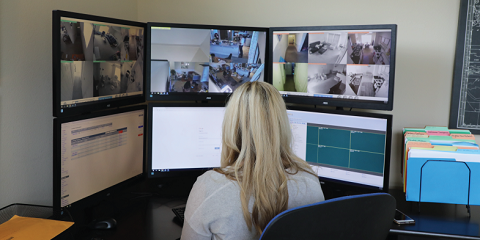The State of America's Direct Support Workforce Crisis 2024
How a Well-Established Model of Care Helped GoodLife Adapt to COVID-19
Share this pageby Staff at GoodLife Innovations
GoodLife Innovation’s history is rooted in putting people first. Our mission is to make a meaningful difference in the everyday lives of seniors, individuals with disabilities, and those who support them. We aim to do this by transforming lives through deep relationships, learning, respect, innovation, exceeding expectations, and achieving results.
In order for any of this to happen, we must consistently monitor and adjust our practices to ensure each resident is safe and well-cared-for. The importance of our adaptability has never been more evident than during COVID-19.
Established Technology Supports Quick Response
In response to the coronavirus, GoodLife quickly created a response plan. With our remote support technology iLink already in place in residential homes, day centers, and within our nursing and behavioral support services, we were abe to seamlessly shift how we deliver care from a safe distance to help prevent the spread of the virus.
“The nature of our community-based models—small, connected homes with few individuals—allowed us to limit resident and staff exposure by ensuring consistency across home visits,” shares GoodLife COO Lauren Vohland. “The same caregivers see the same residents every day, limiting risk for the whole community.”
Relying on our well-established and connected model of care, daily operations like data management, leadership meetings, medication management, and wellness checks continued with minimal disruption. Supervision, training, and quality assurance also quickly adjusted to fit into daily schedules remotely, offering efficiency and increased reach—a new strategy we will maintain long after restrictions are lifted.
Taking Action to Reduce Risk
To deliver needed in-home care, GoodLife direct support professionals (DSPs) are taking extra safety precautions, like wearing masks and gloves, to mitigate the risks of transmission and keep residents as safe as possible. Using iLink, residents are reminded and prompted throughout the day to participate in new hand-washing and home-cleaning schedules.
Temperatures and symptoms of both staff and residents are monitored daily, and staff must report any out-of-state travel or potential exposure to the coronavirus.
Currently, we have a no-visitor policy to limit exposure, but that doesn’t mean our residents aren’t able to be social and enjoy their favorite activities. We have a list of approved locations our residents can visit, and our day-services program delivers weekly activity boxes filled with everything from recipes and food supplies to outdoor games.
GoodLife is also rolling out an internal campaign to inspire staff to remain vigilant in their efforts (both at home and at work) to social distance, practice the CDC’s health recommendations, and protect themselves from exposure to the coronavirus in order to keep GoodLife’s vulnerable men and women safe. ”A staff member may not be at risk of contracting the virus, but the individuals they serve might be,” says Lauren. “It’s important that we help our caregivers understand how actions during their personal time can affect the residents they care for and about. It’s all in an effort to keep residents safe and lift up our front-line DSPs that are working so hard.”
Looking Ahead to a Post-COVID World
At the start of the crisis, it was easy for GoodLife to follow the strict guidelines set by state and local leaders. As states lift restrictions and businesses begin opening again, GoodLife is taking things slowly. We are being practical and transparent in our policies and procedures with staff, residents, and families to make participation and compliance easy, realistic, and comfortable.
GoodLife serves individuals of varying health risks—some very low, and others facing extreme vulnerability. As a result, we aren’t letting our guard down against COVID-19. Current reports show the number of cases could spike in the fall and winter. With so many unknowns ahead, we remain cautious, steady, and intentional in our operations, always thinking about what’s best for our residents.
“It’s really about balancing the health and safety of our at-risk residents with their desire to be active again in the community,” says Lauren. “We are evaluating data to shape strategies and manage risk to create individualized plans for residents. We want to teach and coach them on how to best re-enter work, social gatherings, and other activities. Above all, our priority is to keep residents safe so they can live their most fulfilling life.” Learn more about our model of care.
Authored by staff writers at GoodLife Innovations. For more information contact [email protected] and visit our website at www.mygoodlife.org.

